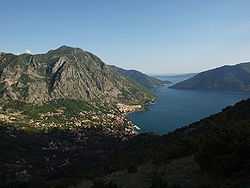Risan
| Risan Рисан | |
|---|---|
| Town | |
 | |
 Risan | |
| Coordinates: 42°30′53″N 18°41′42″E / 42.51472°N 18.69500°E | |
| Country |
|
| Municipality | Kotor |
| Population (2011) | |
| • Total | 2,048 |
| Time zone | CET (UTC+1) |
| • Summer (DST) | CEST (UTC+2) |
| Area code(s) | 032 |
| Vehicle registration | KO |
Risan (pronounced [rîsan], Italian: Risano, Serbian Cyrillic: Рисан, Albanian: Rizoni) is a town in the Bay of Kotor, Montenegro. It traces its origins to the ancient settlement of Rhizon, the oldest settlement in the Bay of Kotor.
Lying in the innermost portion of the bay, the settlement was protected from the interior by inaccessible limestone cliffs of the Orjen mountain, the highest range of eastern Adriatic, and through several following narrow straits in the Bay of Kotor from the open sea.
While the Krivošije karst plateau that hangs steep above the narrow shores of Risan bay receives over 5000 mm rain annually (European record), several strong karst springs that form a short brook collect in the narrow cultivable belt at Risan.
History

| Natural and Culturo-Historical Region of Kotor | |
|---|---|
| Name as inscribed on the World Heritage List | |
 | |
| Type | Cultural |
| Criteria | i, ii, iii, iv |
| Reference | 125 |
| UNESCO region | Europe and North America |
| Inscription history | |
| Inscription | 1979 (3rd Session) |
| Extensions | 1979-2003 |
The earliest mention of Rhizon dates back to the 4th century BCE, as the main fortress in the Illyrian state where Queen Teuta took refuge during the Illyrian Wars. The degree of Hellenization at Rhizon was very high.[1] In Roman times, Rhizinium is documented as an oppidum civium Romanorum, and the most prosperous time for Roman Rhizinium came during the 1st and 2nd centuries, when huge villas were made in the area and the city had 10,000 inhabitants. Five mosaics are the most valuable remains of that period - not only for Risan but also for Montenegro.[2] The invasions of the Avars and Slavs left the city deserted. The last reference of a bishop in Risan dates back to 595.
In the 10th century, the Byzantine emperor Constantine Porphyrogenitus includes Risan among the inhabited towns of Travunia, while the priest of Doclea considers Rissena to be a district.
During the Middle Ages, Risan lost the significance it used to have in the ancient times. In the mid-15th century, Risan was referred to as a town of Herceg Stjepan. In 1466, the Venetians offered to give Brač island and a palace in Split to Herceg Stjepan, in exchange for his two towns (Risan and Novi) in the Boka Kotorska. In 1482, the Turks took Risan, together with Herceg Novi, from Herceg Stjepan's son Vlatko.
Only in 1688 Risan became Venetian as part of the Albania Veneta with the venetian name of Risano, enjoying a temporary economic growth. In the following centuries Risan has had the same fate as the whole of Dalmatia. It was for a few years during World War II part of the Kingdom of Italy in the Italian Governatorate of Dalmatia and actually it is part of the newly independent Montenegro.
According to the 1627 population census, Risan had 800 citizens. 570 were Muslims, 150 Orthodox and 80 Catholic.
Modern Risan
In the present-day Risan, there are no elements that could connect it to the medieval town. Risan by the sea was probably just a settlement. However, on the Gradina hill, above the famous archeological site of Carine, a fortification is situated containing remains of an Illyrian-Greek acropolis, as well as the medieval and Turkish stratum. The position of the fortification was excellent, particularly for the control of Risan – Onogošt route, while the hilltop itself was inaccessible.
Today Risan is a small port with roughly 2000 inhabitants (in 1900: around 5000 inhabitants; of them 80% Orthodox Christians, 20% Catholics) where logs from the vast virgin forests of the Bijela gora are shipped mostly to Italy. Risan is a tourist destination that has a hotel called after its most famous citizen, Queen Teuta, with accompanying fine beaches.
Risan is in the northern section of the Municipality of Kotor
See also
- List of Illyrian cities
- Natural and Culturo-Historical Region of Kotor
- Albania Veneta
References
- ↑ Épire, Illyrie, Macédoine: mélanges offerts au professeur Pierre Cabanes by Danièle Berranger, Pierre Cabanes, Danièle Berranger-Auserve, page 130
- ↑ Video of beautiful Roman mosaics
External links
| Wikimedia Commons has media related to Risan. |
- Photos from Risan: fotokate.pl
- Photos from Risan: | Postcards from the Transition
- MZ Risan
- Venetian Risan and the Bay of Cattaro (in Italian)
| ||||||||||||||